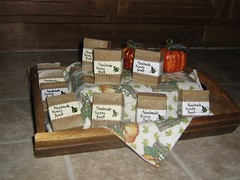
In making the decision to make heathly food for my family, one of the most obvious changes had to be my choice in flour. I'd always bought white flour. It's what I was used to. But when I learned how little white flour actually does beneficially for our bodies, I was forced to reconsider.
So just how bad is white flour for us? A kernel of wheat is made of three parts: the germ, the bran, and the endosperm. Since the germ is what germinates into a plant, it is, in a plant sense, alive. When the bran deteriorates, the wheat goes bad the way oil goes rancid. In order for flour to last longer on the store shelf, some "wise" fellow decided to remove the germ so that the flour would have longer lasting power. (The bran is removed to make a finer textured flour.) Back when this was discovered, vitamins had not yet been discovered. Unfortunatly, what they didn't know has hurt us.
Since the anioxidants and folic acid are found in the endosperm, that isn't lost in refined white flour. But the fiber, protein, vitamins, and minerals are found in the germ and bran. Those are lost almost entirely. And if you buy unbleached flour you may still get some benefit from it (if it hasn't sat in a warehouse for too long.) Then somewhere along the way, some other "wise" fellow decided that the off-white color of flour was unacceptable. What it was being compared to, I have no idea. So now flour must be bleached so that it is pure white. Bleaching, however, kills off any remaining nutrition to the refined flour. Think of what bleach does for your kitchen sponge. So now flour must be enriched. But as we are finding out more and more, most forms of minerals and vitamins that are use to "enrich" our foods are absolutely inabsorbable by our bodies! It's sorta like being deficient in calcium and trying to eat crushed oyster shells to increase our calcium. While there is indeed a good amount of calcium in crushed oyster shells, our bodies are not equiped to handle it in that form. (For chickens, however, it's perfect!)
I once read something along the lines of this: if it has to be enriched, there's probably nothing of value left in it to make it worth eating.
So I switched to whole wheat flour. It's been a learning curve, because the properties of white and wheat flours are different. They just behave differently in recipes. I do keep a bit of white flour around for special treats, or the occasional recipe where white flour can't be replaced. But all in all, the transition to whole wheat has been an enjoyable one, and that says a lot with three young children who love to be picky eaters!

